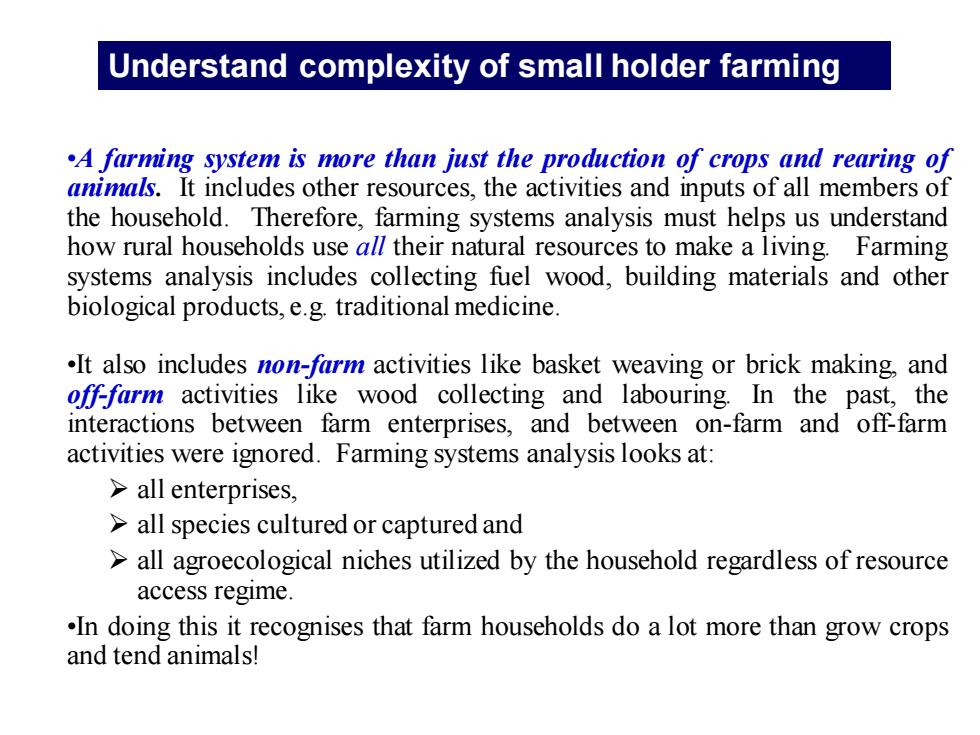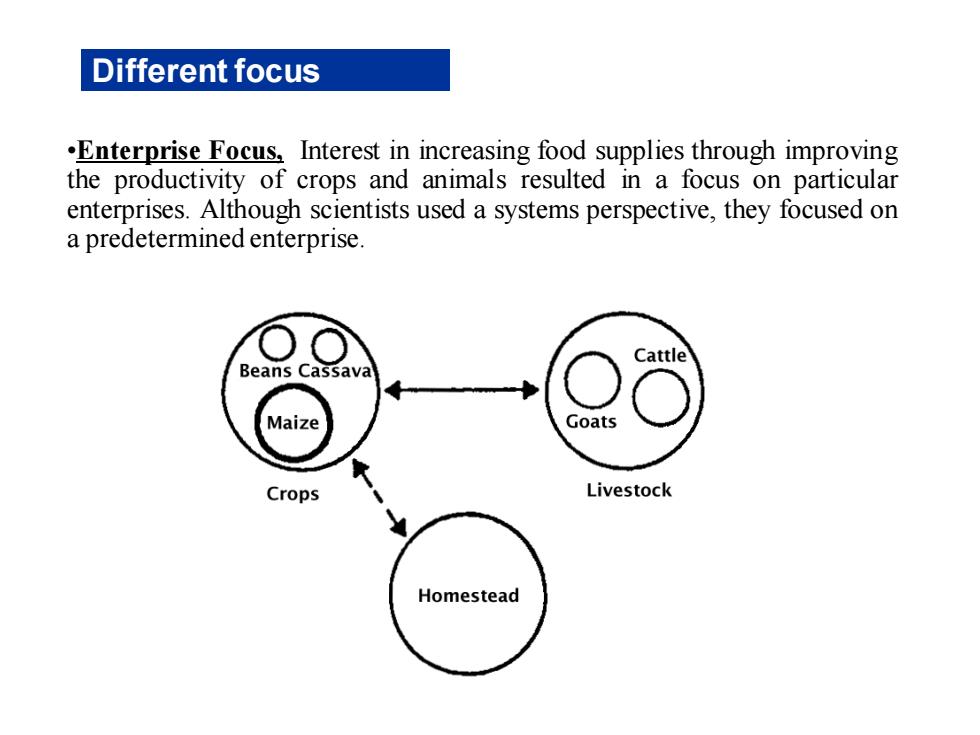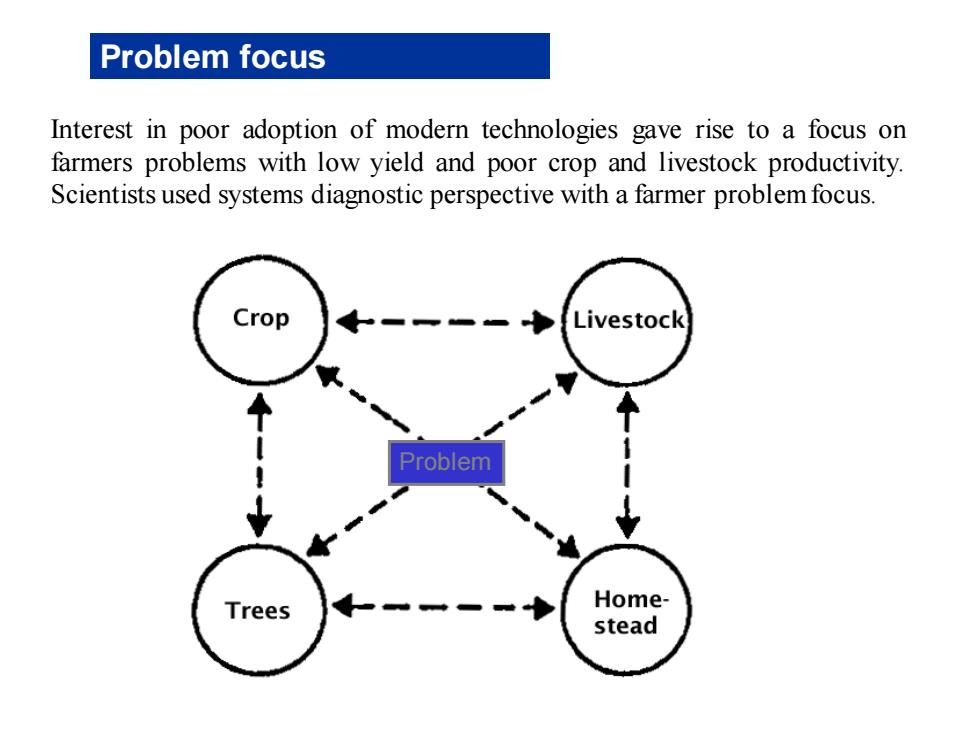
Transitory Agricultural Systems: Nomadic pastoralism游牧; Shifting Cultivation遊墾 Settled Agriculture: 農耕 Arable Systems; 畜牧 Pastoral Systems; 大田農耕 Plantation Agriculture; 小農農耕 Farm-Houshold (Small-farm) Agriculture; 農漁牧混合制度 Mixed Farming Systems; Urban Agriculture 都會農耕 (包括市民農園、屋頂菜園等) 農業生產制度 (Agricultural System)
Transitory Agricultural Systems: Nomadic pastoralism游牧; Shifting Cultivation遊墾 Settled Agriculture: 農耕 Arable Systems; 畜牧 Pastoral Systems; 大田農耕 Plantation Agriculture; 小農農耕 Farm-Houshold (Small-farm) Agriculture; 農漁牧混合制度 Mixed Farming Systems; Urban Agriculture 都會農耕 (包括市民農園、屋頂菜園等) 農業生產制度 (Agricultural System)

•A farming system is more than just the production of crops and rearing of animals. It includes other resources, the activities and inputs of all members of the household. Therefore, farming systems analysis must helps us understand how rural households use all their natural resources to make a living. Farming systems analysis includes collecting fuel wood, building materials and other biological products, e.g. traditionalmedicine. •It also includes non-farm activities like basket weaving or brick making, and off-farm activities like wood collecting and labouring. In the past, the interactions between farm enterprises, and between on-farm and off-farm activities were ignored. Farming systems analysis looks at: ➢ all enterprises, ➢ all species cultured or captured and ➢ all agroecological niches utilized by the household regardless of resource access regime. •In doing this it recognises that farm households do a lot more than grow crops and tend animals! Understand complexity of small holder farming
•A farming system is more than just the production of crops and rearing of animals. It includes other resources, the activities and inputs of all members of the household. Therefore, farming systems analysis must helps us understand how rural households use all their natural resources to make a living. Farming systems analysis includes collecting fuel wood, building materials and other biological products, e.g. traditionalmedicine. •It also includes non-farm activities like basket weaving or brick making, and off-farm activities like wood collecting and labouring. In the past, the interactions between farm enterprises, and between on-farm and off-farm activities were ignored. Farming systems analysis looks at: ➢ all enterprises, ➢ all species cultured or captured and ➢ all agroecological niches utilized by the household regardless of resource access regime. •In doing this it recognises that farm households do a lot more than grow crops and tend animals! Understand complexity of small holder farming

•Enterprise Focus, Interest in increasing food supplies through improving the productivity of crops and animals resulted in a focus on particular enterprises. Although scientists used a systems perspective, they focused on a predetermined enterprise. Different focus
•Enterprise Focus, Interest in increasing food supplies through improving the productivity of crops and animals resulted in a focus on particular enterprises. Although scientists used a systems perspective, they focused on a predetermined enterprise. Different focus

Problem Problem focus Interest in poor adoption of modern technologies gave rise to a focus on farmers problems with low yield and poor crop and livestock productivity. Scientists used systems diagnostic perspective with a farmer problemfocus
Problem Problem focus Interest in poor adoption of modern technologies gave rise to a focus on farmers problems with low yield and poor crop and livestock productivity. Scientists used systems diagnostic perspective with a farmer problemfocus

(Source: Norman and Lightfoot 1992) Natural resources focus Interest in sustainable agriculture gave rise to a focus on the rehabilitation and regeneration of natural resources. Scientists used an ecosystems perspectives with a natural resource systems focus
(Source: Norman and Lightfoot 1992) Natural resources focus Interest in sustainable agriculture gave rise to a focus on the rehabilitation and regeneration of natural resources. Scientists used an ecosystems perspectives with a natural resource systems focus